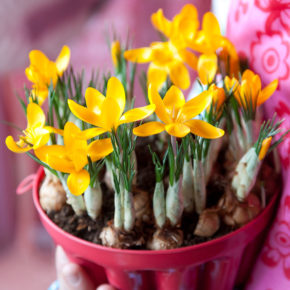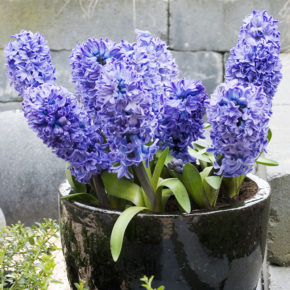Having a plan when it comes to gardening sets you up for future success. Planning now for winter garden projects as well as the awakening of the earth in spring can reap bountiful rewards. Planting pre-chilled bulbs for indoor forcing or gardening in warm climates requires early planning for the best results.
Working with chilled bulbs can help to ease the winter blues. It provides us something to look forward to when spring arrives. Projects involving chilled bulbs are one of the more difficult garden projects when it comes to gardening with flower bulbs. If you have the right knowledge it will be both fun and rewarding. Learn more about gardening with chilled bulbs below with 10 chilled bulb basics. Our 15 tips and tricks for indoor forcing are helpful to make the process fun and successful.
Pre-Chilled Bulbs 101
What does it mean to force bulbs? Forcing bulbs is the process of manipulating bulbs to bloom outside of their typical growing conditions. Bulbs are forced when grown in warm climates, indoors, or in containers.
Top 10 Pre-Chilled Bulb Basics
- People who want to force certain bulbs for indoor blooms will need to chill their bulbs in order to get them to bloom.
- Gardeners in southern and warm climates that don’t have the necessary amount of cold temperatures to get their fall-planted bulbs to produce a flower bud will need to chill their bulbs prior to planting in the ground.
- Most popular fall-planted bulbs that require cold temperatures to produce a flower bud and can be used for indoor forcing: tulips, daffodils, crocus, hyacinths, snowdrops, glory of the snow, muscari, and Dutch iris.
- Most bulbs that require cold temperatures in order to produce a flower bud will need a minimum of 12 weeks of temperatures consistently below 50 degrees during the day. Some bulbs require 16 weeks of temperatures consistently below 50 degrees during the day to produce a flower bud.
| Bulb Name | Minimum Chill Time |
|---|---|
| Tulips | 12 Weeks |
| Daffodils | 13 Weeks |
| Crocus | 12 Weeks |
| Hyacinths | 12 Weeks |
| Snowdrops | 8 Weeks |
| Glory of the Snow | 10 Weeks |
| Muscari | 10 Weeks |
| Dutch Iris | 8 Weeks |
- Popular bulbs for indoor forcing that don’t require cold temperatures include paperwhites and amaryllis
- Start the chilling process as early as September and as late as mid-December depending on where and how you are planting the bulbs. The earlier you start the chilling process the earlier you will have blooms.
- If you don’t have time or a place to chill the bulbs you can purchase bulbs that have been pre-chilled prior to shipping. Pre-chilled bulbs have been cooled by suppliers who sell them, such as Tulip World.
- When working with bulbs that have been pre-chilled for you it is important to keep them cool upon receiving them. Plant them in pots as soon as possible, store the pots in a cold location. If you cannot plant the pre-chilled bulbs in pots right away continue to keep them cold by storing them in your refrigerator.
- Bulbs that have been chilled can be planted in warm climates as late as mid-January.
15 Indoor Forcing Tips & Tricks for Pre-Chilled Bulbs
- Tip Chilling bulbs works best by storing them in a refrigerator. Temperatures are best controlled in a refrigerator.
- Tip Keep fruits and vegetables out of the refrigerator you are using to chill the bulbs. Certain fruits and vegetables emit ethylene gases that will cause the bulbs to rot.
- Tip Root development is critical during the chilling process. Allow for enough time for roots to develop before leaf and bud growth happens.
- Tip Plant your bulbs in containers prior to chilling them. Place the potted bulbs in the refrigerator at the beginning of the chilling process.
- Tip If you don’t have a refrigerator to chill the bulbs and live in a cool climate you may store them outside. If storing the potted bulbs for chilling outside it is best to bury the pots. Burying the pots helps to insulate the bulbs which protect them from the damages that freeze and thaw cycles can cause. If voles and squirrels are a problem in your area protect the buried pots by encasing or covering them with chicken wire or hardware cloth.
- Tip Use a spray bottle to keep the soil moist during the chilling time.
- Tip When planting bulbs in pots for indoor forcing the tips or “necks” of the bulbs should be visible and about level with the soil surface.
- Trick Grow tulips in vases or containers with water and pebbles with this trick: Force tulips in pots with soil so they grow roots. When the leaves, stems, and buds have formed remove the bulbs from soil. Wash the soil off the bulbs and place in a glass container with pebbles or stones and water.
- Tip Hyacinth bulbs and paperwhites can be grown in a vase with only water or pebbles.
- Trick Layer various types of bulbs in the soil in the pot for longer bloom time. Plant larger bulbs near the bottom of the pot and smaller bulbs near the top of the pot. Allow for at least 6” of soil below the bottom layer of bulbs for root development.
- Trick Add moss or succulents to the planter once the bulbs have sprouted. When the bulbs are done blooming you will still have greenery to enjoy in the pots.
- Tip Plant your bulbs for indoor forcing in a pot that has holes in the bottom for drainage.
- Tip After the initial chilling period of 12-16 weeks slowly introduce the bulbs to warmer temperatures. Start by moving the pots to a location between 50 and 60 degrees for 3-4 weeks and indirect light.
- Trick Force bulbs in pots all winter and plant the forced bulb pots in containers outside in spring with pansies and other cool-weather annuals.
- Tip Check your bulbs on a weekly basis during the growing process to make sure the soil is not too dry or too wet.
The Time to Chill is Now
Now that you have the basics along with some handy tips and tricks on gardening with chilled bulbs you should be ready to get planning and planting. In future years, you can plan even better and start chilling your bulbs in September when flower bulbs first start shipping. With enough planning, it is possible to have tulips and hyacinths blooming in December for the holidays. If you are reading this in October, November, or early December there is still plenty of time to start chilling bulbs yourself. There is always the option of buying pre-chilled bulbs if you don’t have enough time to chill them for spring blooms. If you want bulbs blooming in your home this winter or early spring but don’t want to put the work in you can always buy a pre-potted bulb garden!
Keep an eye out for more blog posts related to indoor forcing and working with pre-chilled bulbs: Forcing Tulips, Planting a Layered Indoor Garden, Hyacinth Forcing 3 ways, Forcing Daffodils, and What to Do With my Potted Bulbs?





